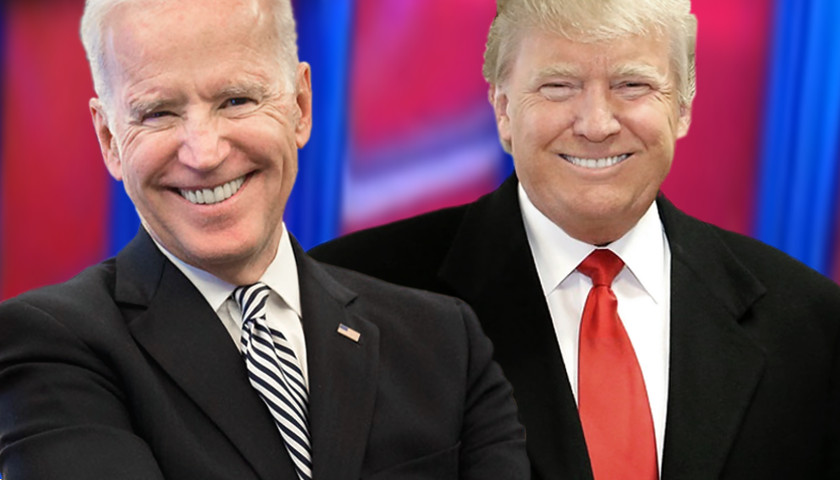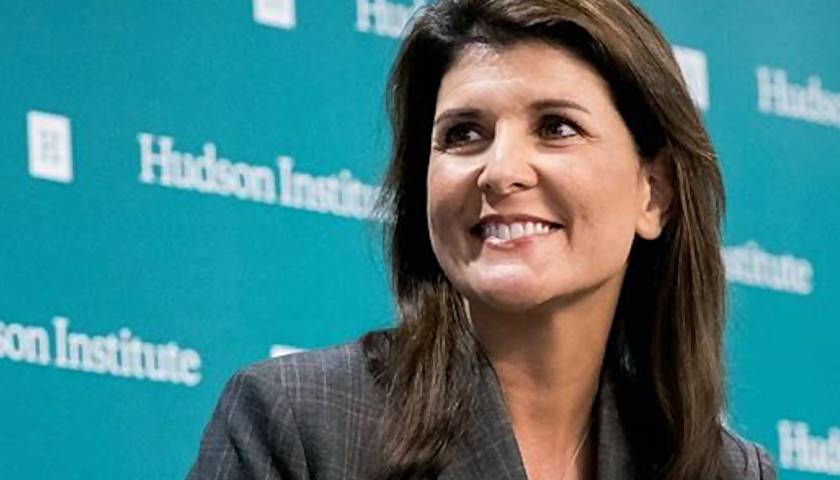by Andrew Trunsky
Democratic nominee Joe Biden leads President Donald Trump in six of the most competitive battleground states as both candidates amp up their fundraising efforts and place multimillion dollar ad buys just over seven weeks out from the election, according to a Daily Caller News Foundation review.
In 2016, Trump pulled off an upset win after flipping Wisconsin, Michigan and Pennsylvania. Now, those three states, in addition to Arizona, Florida and North Carolina, are likely to decide the winner of November’s presidential election.
The DCNF reviewed polling, fundraising, ad spending, demographics and more to determine both candidates’ standing in each battleground state.
Though the states, which total 101 electoral votes, are unique, several overarching strategies have emerged for both Trump and Biden.
In the upper Midwest, experts say Trump must aim to drive up turnout among white voters without a college degree, while the former vice president must try to accomplish the same among younger voters and voters of color. In southern states like Florida, Trump is trying to build on his relatively strong support from Hispanic Americans, while Biden is seeking to hold his strong support among the state’s disproportionately large older population.
Wisconsin
 Four years ago, Trump capitalized on Hillary Clinton’s months-long absence from the Badger State, winning Wisconsin by approximately 23,000 votes. Since then, however, Democrats have ousted Republican Gov. Scott Walker and invested enormous resources into the state. The Democratic Party also chose Milwaukee for their convention, though the event was scaled back significantly due to the coronavirus pandemic.
Four years ago, Trump capitalized on Hillary Clinton’s months-long absence from the Badger State, winning Wisconsin by approximately 23,000 votes. Since then, however, Democrats have ousted Republican Gov. Scott Walker and invested enormous resources into the state. The Democratic Party also chose Milwaukee for their convention, though the event was scaled back significantly due to the coronavirus pandemic.
Biden held a seven point lead over Trump as of Sept. 9, according to FiveThirtyEight’s polling average, but Trump has out-raised him, bringing in $3.4 million to Biden’s $1.3 million according to Federal Elections Commission data.
Though Biden has maintained his lead, a victory in November is no sure thing, GOP strategist Brian Reisinger told Politico, referring to Clinton and former Democratic Sen. Russ Feingold, both of whom held leads over their opponents only to lose their elections.
The August shooting of Jacob Blake in Kenosha catapulted Wisconsin into the national spotlight, keeping protests and riots a central issue of the 2020 race. In the wake of the unrest, Republicans attempted to portray Biden as willing to condone the violence.
Biden has since explicitly condemn rioting and visited Kenosha.
Trump has raised over twice as much from Kenosha residents than Biden, according to Open Secrets, but the two most recent Wisconsin polls showed Biden up by six and eight points.
Both Trump and Biden have focused on gaining support from suburban voters around Madison and Milwaukee, areas that were crucial to Democratic Gov. Tony Evers’s victory in 2018, election results show.
For Trump, the key is driving up turnout among his base and among white voters without a college degree, which make up a disproportionately large share of Wisconsinites who did not vote four years ago, according to election forecaster Dave Wasserman.
Michigan
Trump’s campaign has acknowledged that Michigan may be the most challenging state to carry again, given that that he won by fewer than 11,000 votes out of approximately 4.7 million cast.
Four years ago, Trump benefited from a low turnout in black voters throughout the state and an opponent who constantly struggled to attract working-class voters. Unlike Clinton, Biden has strong support from blue-collar workers, according to The New York Times, leaving Trump with a microscopic margin for error this time around.
Since Trump’s 2016 victory, suburban voters outside of Detroit have flocked to Democrats, exit polls show, resulting in Democratic candidates winning the governorship, two congressional seats, the attorney general and the secretary of state in the 2018 midterms.
Though Biden is by no means guaranteed to win the state, he is likely to benefit from far stronger support from suburbanites and voters of color than Clinton received four years ago, according to Politico. To hold the state, Trump will have to mitigate his party’s losses in the suburbs while driving up turnout from rural voters across the state.
Biden also leads Trump by over seven points in the state, according to FiveThirtyEight.
Trump has raised over twice as much as Biden from Michiganders throughout his first term, according to the FEC, his campaign halted ad spending in the state in late July, according to The New York Times.
Pennsylvania
Trump’s narrow 2016 victory was fueled by strong support in western suburbs and rural areas throughout the state, making him the first Republican to win the state since George H.W. Bush in 1998. Now, his campaign is relying on a similar strategy once again.
“President Trump’s historic win was made possible in part by flipping key Pennsylvania counties, and those same counties are on our road to victory again this November,” Rachael Lee, the Trump Victory Fund’s Pennsylvania communications director, told the Daily Caller News Foundation.
“Now, in 2020, thanks to our permanent, data-driven ground game, we are able to play to win across all 67 Pennsylvania counties,” she said.
Though Biden has led in almost every poll, his lead has narrowed in recent weeks. He leads by five points in the state, according to FiveThirtyEight, down almost two points from early August and down over three points from late June, leaving ample opportunity for both candidates to rise in the polls.
Both candidates have had strong fundraising support in the state as well, with Trump and Biden raising $8.1 million and $7.4 million, respectively, according to the FEC.
Biden surrogates say that the race is neck-and-neck and fear that Trump’s rock-solid support from his base will be enough to give him Pennsylvania’s 20 electoral votes.
“What I’m seeing is that it’s anyone’s race. I think Trump has a real shot at winning reelection,” Anna McIllmurray, a Philadelphia-based progressive strategist, told Politico.
“The Democratic party establishment and the pollsters were in 2016 deeply out of touch with the hearts and souls of Americans, and particularly the struggle of black, brown and white working-class people,” she said. “And that hasn’t changed.”
Arizona
Unlike Trump’s victories in the upper Midwest, his 3.5 point victory in Arizona four years ago was hardly an upset in a state that has not voted for a Democratic presidential candidate since Bill Clinton in 1996.
However, Trump only won the state with 48% of the vote, and Biden has pulled ahead in the state with less than two months until the election.
The former vice president leads Trump in the state by 4.7 points, according to FiveThirtyEight, and has also reserved $17 million in ads from now until the election, compared to $6 million reserved by Trump, according to Politico.
Despite his trailing in the polls, Trump has raised over $8 million from voters in the state, compared to approximately $2.2 million, according to the FEC.
Arizona’s demographics have also been changing faster than almost every other state in the country, according to the Census Bureau. The state’s population increased nearly 14% throughout the last decade, fueled by growing Hispanic and college-educated suburbanites, both of which are groups that tend to vote Democratic.
“Arizona is definitely one of our most flappable states because of the demographic change, the Latino population is growing so fast in Arizona, coming of age, mostly being driven by young, U.S. born, all citizens,” Matt Barreto, co-founder of Latino Decisions, told Politico.
Trump won Maricopa County, which includes Phoenix and 60% of the state’s registered voters, by approximately three points in 2016. But his 2020 success in the state is contingent on not only mitigating Biden’s gains in Phoenix and its surrounding suburbs, but also driving turnout from voters in rural counties as well.
“[Trump] can’t lose Maricopa County by more than a point or two and still have a hope of winning,” said Republican strategist Chuck Coughlin.
Trump also has to contend with some high-profile Arizona Republicans who have vocally opposed his reelection. Former Arizona Sen. Jeff Flake endorsed Biden last month, while the family of the late Sen. John McCain has frequently criticized Trump for his rhetoric.
Florida
While Biden currently leads Trump by 2.7 points in the state, according to FiveThirtyEight, Florida is as pure a tossup as any state in the country, forecasters say.
Just two months ago, Biden led in the Sunshine State by over six points as its coronavirus case count skyrocketed and Trump’s approval plummeted. More recent polls, though, show the raced tied as Trump has made inroads with the state’s disproportionately large Hispanic population, fueled by his support from Cuban-Americans.
Biden, conversely, has held onto his statewide lead thanks to the state’s younger voters, who support him 49%-41%, and senior voters, who support him over Trump 49%-48%, according to a recent AARP poll.
While still behind in the polls, Trump has raised nearly $32 million from Florida voters through July, according to the FEC, showing how the same bloc of voters that won him the state in 2016 and won Republicans the governorship and a Senate seat is determined to reelect the president in November.
Democratic voters have mobilized behind Biden as well, underscored by their record-breaking turnout in the state’s August primary. Not only did 1.7 million Democrats vote, edging Republican turnout by over 40,000 votes, but they also outvoted Republicans among first-time voters by about 25,000 votes as well, Politico reported.
Biden and Trump, both keenly aware that Florida’s 29 electoral votes could be the clincher in a close election, have invested heavily across the state, but the former vice president has outspent the incumbent $20.5 million to $7.8 million, according to The Washington Post.
North Carolina
Of these six states, Trump remains strongest in North Carolina. Polls show Biden ahead by only 1.7 points, according to FiveThirtyEight, with just 48% support, meaning that both candidates could capitalize on the state’s swing voters in the suburbs surrounding cities Charlotte and Raleigh.
Those voters are “the swingiest of the swing states” said Chris Cooper, a political scientist at Western Carolina University, referring to North Carolina being the lone state with a competitive races across presidential, Senate and gubernatorial levels.
“We consider this to be the eye of the hurricane politically,” North Carolina Republican Party Chairman Michael Whatley told Politico.
The state was also the first to begin sending absentee ballots to registered voters who had requested them. It received over 750,000 requests in the week since voting began, according to the state’s Secretary of State office.
The total far exceeds the approximately 50,000 ballots requested at this point in 2016, giving both candidates less time to convince early swing voters that may decide both the presidency and the makeup of the Senate.
– – –
Andrew Trunsky is a reporter at Daily Caller News Foundation.




